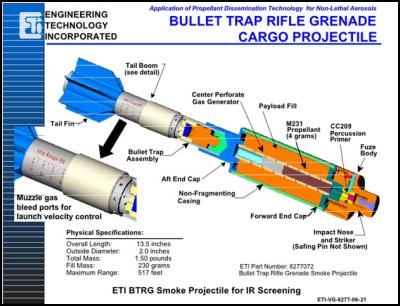US Army Patents Illegal WMD Delivery System
The Sunshine Project
News Release
8 May 2003
Violates Bioweapons Convention

Austin and Hamburg (8 May
2003) - The United States Army has developed and patented a
new grenade that it says can be used to wage biowarfare.
This is in violation of the Biological Weapons Convention,
which explicitly prohibits development of bioweapons
delivery devices.
US Patent #6,523,478, granted on February 25th 2003, covers a "rifle launched non lethal cargo dispenser" that is designed to deliver aerosols, including – according to the patent’s claims - “crowd control agents, biological agents, [and] chemical agents...”
The development of biological weapons delivery devices is absolutely prohibited - “in any circumstance” - by Article I of the 1972 Biological and Toxin Weapons Convention, to which the US is a party. There is no exemption from this prohibition, neither for defensive purposes nor for so called non-lethal agents.
“The development of weapons for biological payloads produces great uncertainty about the US commitment to the Biological Weapons Convention.” says Edward Hammond of the Sunshine Project US, “Thirty four years after the US renunciation of biological weapons, the Pentagon is back in the bioweapons business.”
"Hans Blix might have an easier time finding illegal weapons if he were inspecting near Baltimore instead of Baghdad," says biologist Jan van Aken from the Sunshine Project Germany, referring to the fact that two of the inventors work at the Army’s Edgewood Arsenal north of Baltimore, Maryland. Other inventors work at an engineering firm in Orlando, Florida, where the US Special Forces operate from MacDill Air Force Base.
This grenade is yet another indication of prohibited biological and chemical weapons development projects in the US. It stands in a row with an illegal chemical weapons program focusing on so called non-lethal agents (see below), uncovered last September by the Sunshine Project, with research activities on material degrading microorganisms by the US armed forces (see below), and with a range of questionable biodefense activities that may well suit offensive purposes (see New York Times, 4 September 2001).
http://www.sunshine-project.org/publications/pr/pr080503slide2.html
Slides: "Rifle Launched Non-Lethal Cargo Dispenser"
Eroding Prohibition: So-called non-lethal weapons are blurring the lines between permissable and illegal weapons research. The Army says the new grenade is for the dispersal of “non-lethal” agents. Claims are the legally crucial and most carefully crafted part of a patent. The Army is fully aware of its obligations under the BWC, yet a new bioweapons device was patented. This underscores why "non-lethal" weapons pose such a serious threat. The Pentagon now considers bioweapons work that has been off limits for three decades to be acceptable - if the word “non-lethal” is appended. But not only do many 'non lethal' agents violate treaties themselves, it is worse: US "non-lethal" research is creating and testing hardware that can deliver the full spectrum of biological and chemical weapons.
Pre-emptive Diplomacy: US diplomatic-military policy coordination on “non-lethal” weapons can be seen in its firm resistance to efforts to place the subject on the international arms control agenda. In September 2002, US diplomats vetoed the Sunshine Project’s accreditation to a Chemical Weapons Convention meeting because the Project wanted to discuss “non-lethal” chemical (and biological) weapons. Last week, US diplomats again pre-empted discussion of “non-lethal” weapons, when they blocked the International Committee of the Red Cross from making a speech at the Chemical Weapons Convention Review Conference.
“This grenade is another example of how the Pentagon's so called 'non lethal' weapons programs are consistently chipping away at restrictions on two of the most deadly kinds of arms, biological and chemical weapons. Programs that develop so called non-lethal chemical and biological weapons should simply be abolished,” says Hammond.
Links to items mentioned in this release:
US
program on incapacitating (bio)chemical agents
Anti-material
biological weapons: News
Release


 Greenpeace: Major Deep Sea Mining Company Goes Bankrupt
Greenpeace: Major Deep Sea Mining Company Goes Bankrupt New Zealand Defence Force: Indian And New Zealand Navies Involved In $181m Drug Bust In Indian Ocean
New Zealand Defence Force: Indian And New Zealand Navies Involved In $181m Drug Bust In Indian Ocean Google Cloud Security: North Korea’s Expanding IT Threat - NZ And Other Nations In The Crosshairs
Google Cloud Security: North Korea’s Expanding IT Threat - NZ And Other Nations In The Crosshairs ICHRP: ICHRP Condemns Harassment And Threats Against Victims Of Duterte’s War On The Poor
ICHRP: ICHRP Condemns Harassment And Threats Against Victims Of Duterte’s War On The Poor World Vision: 3.5 Million Displaced Following Myanmar Earthquake And Ongoing Internal Conflict
World Vision: 3.5 Million Displaced Following Myanmar Earthquake And Ongoing Internal Conflict World Butchers Challenge: World’s Top Butchers From 14 Nations Go Knife-to-Knife In Paris
World Butchers Challenge: World’s Top Butchers From 14 Nations Go Knife-to-Knife In Paris